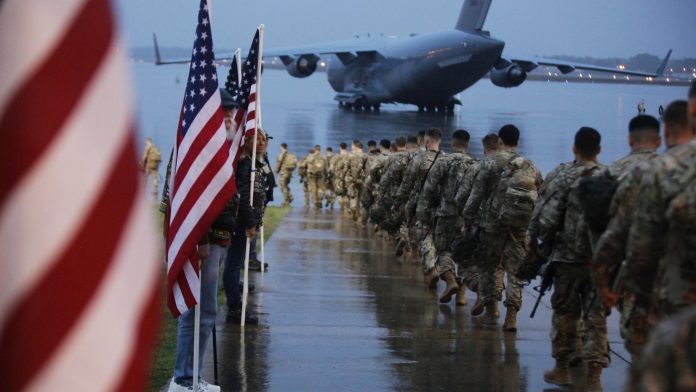
America’s military strategy in Iraq has been thrown into disarray after the Pentagon admitted a top US general mistakenly informed the Iraqi government his troops were preparing to leave.
Here is AFP’s look at what shape a withdrawal could take.
How could troops withdraw?
A senior US military official had told AFP that a hypothetical withdrawal would take weeks, but could be shortened to days in an emergency situation — like being ordered out immediately by Iraq’s government.
Cargo planes would transport equipment by air while troops would likely drive out through the south to Kuwait.
The Monday letter mistakenly sent by US Brigadier General William Seely to the Iraqi government said the US-led coalition would be “repositioning forces in the coming days and weeks to prepare for onward movement.”
Jack Watling of the Royal United Services Institute told AFP: “The coalition would need to map out travel routes, sequence evacuation plans for troops, civilians and contractors and decide what equipment and documents to bring, abandon or destroy.”
What is happening on the ground?
The Pentagon swiftly denied there was a plan to leave Iraq, saying the letter was still a draft.
But there already seemed to be an impact on the ground.
The letter said helicopters would be flying around Baghdad’s Green Zone where the US embassy is located as part of the departure arrangements.
AFP could hear helicopters flying low over Baghdad throughout the night for three nights before the letter was sent.
On Tuesday, Germany said 30 soldiers based in Baghdad and a nearby airbase would “shortly” be moved to Jordan and Kuwait, “together with soldiers from other countries”.
A European diplomat told AFP that a withdrawal of US troops would necessitate all coalition forces leaving Iraq.
Iraq’s caretaker premier Adel Abdel Mahdi has told US ambassador Matthew Tueller and NATO chief Jens Stoltenberg that the government wanted foreign troops out following a vote to that effect by the Iraqi parliament.
Why are troops still in Iraq?
Thousands of foreign troops are deployed across Iraq as part of Operation Inherent Resolve, the US-led coalition formed to fight the Islamic State group.
In 2014, the Iraqi foreign ministry issued an urgent appeal to the United Nations Security Council for help to roll back IS, which was sweeping across Iraq.
The coalition sent troops and special forces to Iraq to “advise and assist” Iraqi forces as they fought IS.
Their deployment was based on an executive-to-executive agreement that was never ratified by Iraq’s parliament.
It was not governed by a detailed arrangement like the 2008 Status of Forces Agreement that expired in 2011.
Other foreign forces are deployed as part of NATO’s mission, established in late 2018 to train Iraqi troops.
Who is deployed, and where?
The bulk of the coalition is made up of 5,200 US soldiers stationed at Iraqi bases, the largest of which is Ain al-Assad in the west.
More are based at Al-Balad and Taji north of Baghdad, as well as four bases in northern Iraq, near the US embassy in Baghdad and in the Kurdish regional capital Arbil.
They are joined by about 400 British, 200 French, and 120 German forces, as well as dozens of other international troops.
There are also thousands of civilian contractors and support staff in Iraq for logistical operations.
Troop numbers have fluctuated recently as US officials said they would deploy up to 4,000 more troops to the region in the wake of tensions with Iran.
At least 150 US troops arrived in Baghdad last week to reinforce security at the US embassy following an unprecedented attack by a pro-Iran mob, and hundreds more have been flown to Taji.
from Defense News by DefenceTalk.com https://ift.tt/2QRtlgF
via Defense News
No comments: